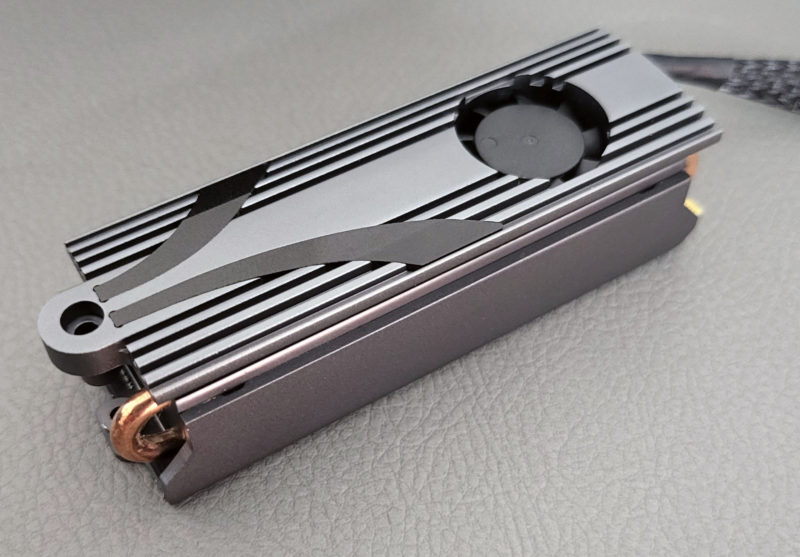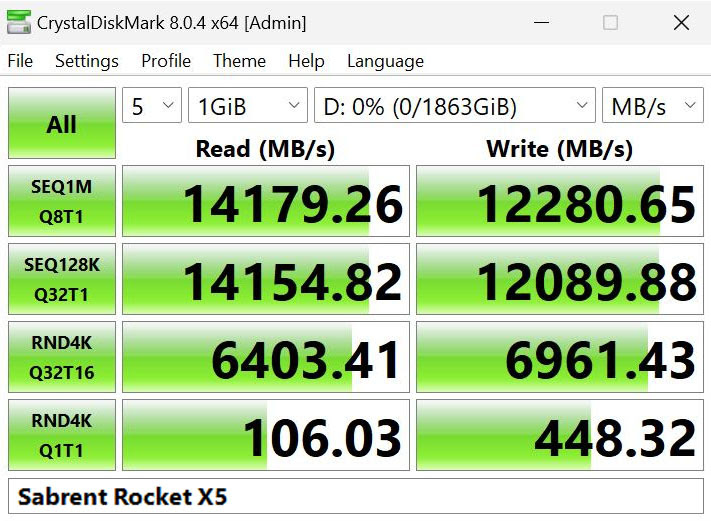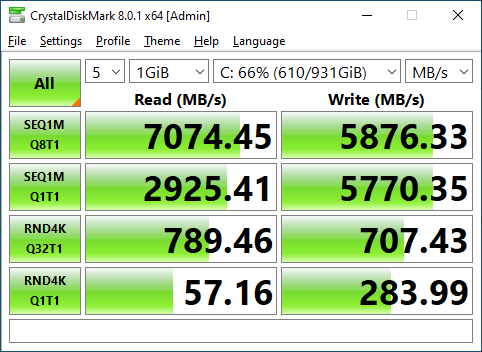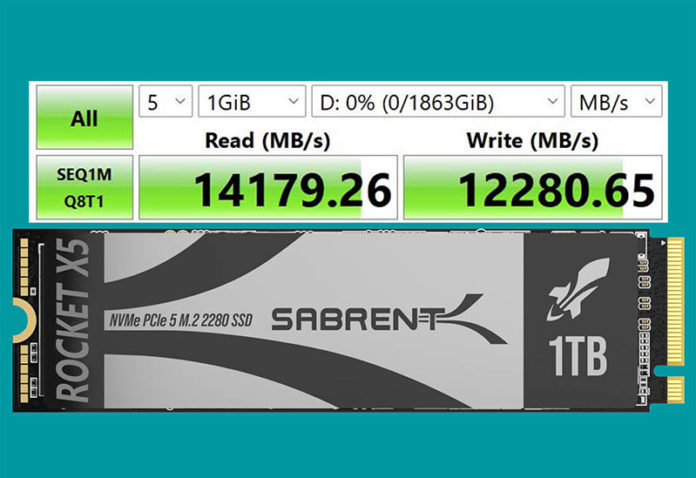The Sabrent Rocket X5 looks like it is going to be an exciting product. While PCIe Gen5 NVMe SSDs promised to deliver twice the sequential speeds of PCIe Gen4 NVMe SSDs, that often has not translated into reality with early drives falling well short of that mark, despite a large price premium. The Sabrent Rocket X5 is not out yet, but the development update shows promising progress.
Sabrent Shows Progress Building the Fastest PCIe Gen5 M.2 SSD
One of the big features of the Sabrent Rocket X5 is its form factor. This is a M.2 2280 (80mm) SSD. M.2 SSDs have become the defacto standard for workstations and even some internal server applications. Sabrent showed the label for the 1TB Rocket X5, but it showed the performance of the 2TB model.

These new drives achieve higher performance but also require a lot more cooling. As a result, Sabrent is developing a M.2 cooler that allegedly does not have a high-pitched fan noise. At the same time, it feels like the industry needs a better solution for M.2 SSDs in general than sticking small fans on each SSD.

The performance of the 2TB Sabrent Rocket X5 is very promising, achieving over 14GB/s sequential reads and 12GB/s sequential writes. This feels more like the numbers we would expect from doubling the PCIe bandwidth than many of the early Gen5 SSDs that would hit 10GB/s sequential writes on this benchmark.

The random 4K low queue depth numbers are good, but those higher queue depth 4K numbers are very strong. Just for comparison (CDM versions are different so the RND4K Q32 numbers are using different thread counts) here is the Sabrent Rocket 4 Plus 1TB M.2 PCIe Gen4 NVMe SSD Review result we got.

That is a huge upgrade.
Final Words
We are excited for PCIe Gen5 NVMe SSDs. Something that feels a bit different in this generation is that the more we see these drives, the more we think there will be a market for lower-power PCIe Gen4 drives that do not offer the performance, but also require less cooling. Still, for those that just want to go fast, we hope the Sabrent Rocket X5 comes out soon so we start the era of high-performance PCIe Gen5 M.2 SSDs.





Those rocket 4 tests posted as comparison are not good to have posted other than than for the first and last tests. Makes it look like a huge increase in places it might not be at 1 thread is going to perform a lot worse than 16. Look forward to seeing the full test.
The benchmark is impressive, assuming that they use the PS5026-E26 controller.
They have exceeded Phison’s results, and what is published in their spec sheet.
https://phisonblog.com/meet-the-phison-e26-ssd-controller/
Agree on cooling – time to leave M.2 form factor behind and move to something like E.1S, and then have the cooling built into the mount area (maybe similar in concept as was done in servers for removeable front-mount HDD trays). For performance-oriented systems, it seems we’ve reached the limit of what air-cooling can provide without being overly loud, or involve thermal throttling. Without some new wonder material, seems time for an industry-standard approach to liquid cooling for GPU, motherboard CPU, chipset, and SSDs; or ??
Granted some work still needed, but modular liquid cooling systems already exist. I’d love a plug (and with a few extra steps) ‘n play cooling system almost as easy as we handle power and data connections, RAM and data drive installs, etc. My take is that such standardization hasn’t taken place due to limited edge cases that needed it.. But we aren’t far away from PCIe 5 drives in workstation laptops
I have a difficult time trusting any Sabrent SSD’s after my Sabrent Rocket 4 bricked on me and they gave me a really difficult time in the warranty process.
@Cliff – Does the Rocket X5 support Direct Storage?
I got burned quite a few times by Sabrent, and purchased their “Rocket 4 Plus” NVMe’s, only to find out that Sabrent doesn’t support DirectStorage and instead forces you to purchase the “Rocket 4 Plus-G” if you want DirectStorage support.
Completely ridiculous, especially when you can’t get 8TB NVMe’s in “Rocket 4 Plus-G” with DirectStorage support.
I’m curious as to whether Sabrent supports DirectStorage in their “Rocket X5” series and Sabrent should support DirectStorage with their entire NVMe lineup.
Sabrent should really offer their “O₂ GO firmware” (that supports DirectStorage) and offer the firmware for every single Sabrent Rocket series NVMe drive, so that users can choose to use the “DirectStorage Optimized” firmware for DirectStorage support.
Instead of forcing consumers to purchase completely different products just to get the “DirectStorage” firmware support.
Sabrent should offer the “O2 GO” firmware on their entire product line (as a firmware download / update) so that consumers can update their Sabrent Rocket firmware and have DirectStorage support enabled.
DirectStorage, as the name indicates, provides a more direct path for textures to reach the GPU by bypassing the CPU and memory. BypassIO is the technology that makes DirectStorage possible. It is a new optimized IO path for reading files. This function removes most of the file system, volume, and storage stack filters to optimize a storage fast path through the system. A traditional storage path from SSD to GPU involves eleven steps for data to arrive at your monitor. With BypassIO, it only takes three steps to get there.
Read more: https://www.tweaktown.com/articles/10154/phison-technology-preview-directstorage-gaming-companion/index.html
Phison I/O+ Firmware for DirectStorage:
https://www.tweaktown.com/articles/10154/phison-technology-preview-directstorage-gaming-companion/index.html
1600MT flash, plus the Phison I/O+ Firmware is basically what Sabrent is calling their “Rocket 4 Plus-G” series lineup.
I’m not familiar with the “Rocket X5” series, but would love to know whether it has a Phison firmware
that supports Microsoft’s “DirectStorage”, for a more direct path for textures to reach the GPU by bypassing the CPU and memory.
The Sabrent Rocket X5 is still based on the same Phison E26 controller (as all other current PCIe 5.0 NVMe drives) and from what we know, the controller is paired to Micron’s 232-layer B58R NAND, a combination that should be able to reach 2400 MT/s across eight channels.
However, it’s not the only drive with this combination of components, so it seems like the magic here might be in the firmware.
So I am assuming that Sabrent has some type of advanced Phison firmware (Phison I/O+ Firmware?) and I am curious as to whether the Rocket X5 supports DirectStorage.
Seagate has already pushed out new firmware updates with DirectStorage support for their FireCuda 530 series:
https://www.techpowerup.com/310053/seagate-releases-directstorage-firmware-for-the-firecuda-530-ssd?amp
Hopefully we can get more details about the Sabrent Rocket X5. TechPowerUp discusses the NAND flash used here:
https://www.techpowerup.com/310971/sabrents-rocket-x5-pcie-5-0-nvme-ssd-shown-hitting-14-gb-s-read-speeds#comments